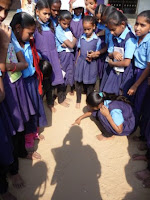Diya is a
lovely girl who was admitted to our school three years back. She became a
darling to the teachers and senior students with to her chubby chicks, bright
eyes and fast learning. She is very active in adapting new things and
participating in co-curricular activities.
She used to
mingle with seniors easily. She would go to class seven whenever she finds some
co-curricular practices taking place there; and she would participate in
them. She strives for new learning. She
is after her class teacher for-what next? By chance she has to remain absent;
she would ask her class teacher for revision. Though she is friendly, she doesn’t
like to perform the role of the group leader. She likes to read a lot.
But, there
is a change in her this year.
Diya has a
younger sister, Hina, and she was admitted in class one this year. Suddenly, Diya
became mature. It reflects in her face and behavior.
Today, we
were going to visit the Community Science Center at Vidhayanagar with selected
students from standard 5, 6 and 7. We hired a van with a capacity of 12-15
students. The van was packed and Diya rushed to the teacher: Please, I want to
join, to see.
But, it is
for standard 5, 6 and 7 only. Your turn will come when you will come to
standard 5.
I want to
see, come.
The teacher
knew that though this visit is for those who understands the basic concepts of
Science, the teacher also understands that visit to such places can do wonders
to the students like Diya. The teacher asked the students in the van- can you
make place for Diya?
O sure!
‘Sarika
also wants to come.’
OK fine.
Take the permission from Principal madam and your class teachers.
They run to
Principal-Kamalaben but could not speak. Kamalaben come to know the matter and
she told,
‘OK, Come with us .’
Suddenly,
Diya said, ‘I can’t. I have to take care of my sister.’
But, we are
returning in school time. There will not be any problem.
Sarika
came, Diya didn’t.







